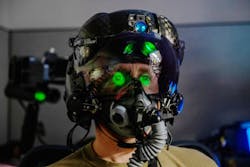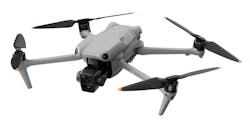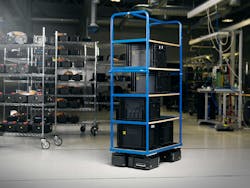Celebrate “May the Fourth” with Real-World Star Wars Tech
What You'll Learn
- Hacksmith Lightsaber
- Hanson Robotics’ Sofia
- RedKey R20 Robotic Vacuum
- Apptronik's Apollo Robot
- F-35 Advanced Helmet
- DragonFire Laser Directed-Energy Weapon
- DJI Air 3
- Smartphones and Tablets
- Voxon VX2-XL Volumetric Display
- Chain Codes/Aadhaar Unique Identity Number
- Wheel Me Genious 2
- Volonaut Airbike
Every year on May the Fourth, Star Wars fans across the planet celebrate the iconic franchise’s lasting legacy. May the 5th is a new addition to the celebration—a welcome one. For this year’s celebration, we’re not looking at projects and props that mimic the technologies found in a galaxy far away. Rather we highlight the real-world technologies that function similarly to those found in the Star Wars universe.
From retractable plasma sabers and humanoid robots to next-gen fighter helmets and drone companions, here’s a roundup of the latest innovations inspired by our favorite movies, books, and TV shows.
Hacksmith Lightsaber
Hacksmith Industries’ Plasma Retractable Lightsaber is the closest replica of a Star Wars lightsaber in existence. James Hobson engineered the replica, which features a retractable plasma beam capable of reaching temperatures up to 4,000°F, enough heat to slice through steel. The saber uses a mix of liquid propane gas and oxygen as fuel, which makes it stable and enables the blade to extend and retract without deforming.
To increase that stability, Hobson and his engineering team took advantage of laminar flow, which helps maintain a steady and uniform stream of fuel. The retractable blade was done by controlling the gas flow. Activating that flow ignites the plasma blade, while shutting it off causes the blade to retract, mimicking the on-off functionality of a traditional lightsaber.
The saber is fueled via a back-worn tank that feeds directly into the lightsaber hilt, and while it doesn’t function like those in the movies, it comes pretty close.
Hanson Robotics’ Sofia
Sofia, from Hanson Robotics, takes some cues from C-3PO in the form of simple social conversation, public speaking, and basic Q&A across topics. And while she doesn’t speak over 1 million forms of communication, she does have conversational AI.
Since her introduction back in 2016, Sofia has garnered worldwide recognition for her lifelike appearance and facial expression capabilities. The robot’s AI architecture was designed using scripting software, a chat system, and OpenCog, an AI system aimed at general reasoning. Those abilities allow her to process speech, recognize faces, and engage in basic conversations.
RedKey R20 Robotic Vacuum
The RedKey R20 Robotic Vacuum and other robotic cleaning robots share the same familiarity as those cleaning and maintenance droids that inhabit the Star Wars universe. The real-world counterparts carry out the same jobs as those in the galaxy, far, far away, including functioning autonomously, avoiding obstacles, and people while handling their assigned duties.
The RedKey R20, for example, can handle both mopping and vacuuming. It uses an LDS laser for navigation, along with dual-line laser and acoustic wave sensors for precise mapping and obstacle avoidance. Though it doesn’t provide beeps and whistles for droid communications, it does a great job at handling dirty floors.
Apptronik's Apollo Robot
The Star Wars universe teems with droids that serve myriad different jobs and functions, including droids for logistics and heavy loads. Apptronik’s Apollo humanoid robot is designed for similar roles, including unloading trailers, palletizing, and case picking.
The robot, standing at 5 feet 8 inches, is designed for tasks that are physically repetitive, demanding, and hazardous to humans. Apollo can lift up to 55 pounds, is equipped with hot swap battery packs, and incorporates advanced force control architecture and adjustable perimeter zones to provide safe operation around humans.
Mercedes-Benz is interested in the robot. The automaker is testing Apollo in its factories to perform tasks such as delivering parts to assembly lines and conducting quality inspections. It's ideal work for droids in any universe.
F-35 Advanced Helmet
The flight helmet for the F-35 fighter is similar to those worn by Mandalorians and Boba Fett, which feature advanced head-up displays (HUDs) for targeting, tracking, and other applications. Known as the Gen III Helmet Mounted Display System (HMDS), the headgear features a full HUD that’s projected on the visor and features information such as speed, altitude, targeting, and navigation data.
One of the most amazing features of the Gen III is its integration into the F-35’s Distributed Aperture System (DAS), which lets the pilot see through the aircraft like it’s invisible. The system uses real-time video from external infrared cameras that are projected inside the helmet, enabling vision all around the plane and even beneath it.
DragonFire Laser Directed-Energy Weapon
Ships and bases in the Star Wars universe are equipped with laser cannons for fighting and protection, similar to the directed-energy weapons that militaries use here on Earth. DragonFire UK has similar tech with its DragonFire Directed-Energy Weapon, which is designed to provide defense against drones, missiles, and artillery.
DragonFire is a multi-company collaboration, with each providing key technologies for the weapon. The beam director focuses and directs the laser beam (it’s being developed by Leonardo UK), while QinetiQ is handling the 50-kW laser. The third technology, the command-and-control system, is being developed by MBDA UK. A production version of DragonFire is expected to enter service onboard Royal Navy ships in 2027.
DJI Air 3
The Star Wars universe also has probe and assistance droids that are designed to find rebels or follow users for any number of applications. DJI’s Air 3 drone is similar—it leverages the company’s “ActiveTrack” system so that it can follow a subject autonomously.
The drone comes outfitted with an impressive array of hardware, including a wide-angle camera, telephoto camera, Pilot Assistance Systems (APAS 5.0) and ActiveTrack 5.0 for intelligent object tracking and automated flight paths. The Air 3 also has 46 minutes of flight time, a 12.4-mile range, and a max speed of 47 mph.
Smartphones and Tablets
The Star Wars universe has its own version of video phones to talk with others, but more advanced versions can be found here on Earth. Smartphones such as the iPhone and iPad offer more productivity than simple video calls and data sharing.
The advanced systems-on-chip (SoCs) in flagship mobile devices often use 8-core processors, gigabytes of RAM, advanced OLED displays, and AI assistants that help with everything from navigation to health monitoring.
Voxon VX2-XL Volumetric Display
Star Wars’ iconic 3D holograms are still out of reach here on Earth, but the Voxon VX2-XL is similar in that it allows users to view 3D objects at any angle without needing glasses or headgear. The 3D volumetric display is the world’s largest and features a display volume that measures 512 mm in diameter and 256 mm in height (20.5 × 10 in.).
The VX2-XL can render interactive 3D volumetric holograms with up to 16 million color voxels. It uses a high-speed rotating LED array in tandem with a custom volumetric graphics engine to project 3D images into a physical space.
Chain Codes/Aadhaar Unique Identity Number
In Solo: A Star Wars Story and The Mandalorian, chain codes were used as digital identification tags tied to an individual’s identity. Those codes are used to track and verify citizens in the post-Empire era, essentially serving as personal biometric passports or digital ID numbers. They’re encoded with everything from a person's origin to their status in the galaxy. This mught be a case where Star Wars was influenced by the block-chain technology of today.
While we don’t have anything like chain codes tracking people in the real world, we do have similar tech in the form of digital IDs and e-Passports, which provide biometric data such as fingerprints, facial-recognition data, and encrypted identity info. India, for instance, has developed a biometric ID system known as Aadhaar, which links fingerprints and iris scans to a 12-digit ID number. It’s used for everything from banking to travel.
Wheel Me Genious 2
Some droids in the Star Wars universe are designed to handle heavy payloads at starports throughout the galaxy. Midpoint in Episode 3 shows off some payload-carrying droids at a space port, in the background of course. Here on Earth, we have similar robots that are designed to autonomously handle heavy loads for industrial applications. Wheel Me’s Genious 2, a modular set of smart wheels, is capable of moving up to 1,760 lbs. when in an eight-wheel configuration.
The Genius 2 setup utilizes four autonomous wheels, with one acting as the central control unit. The design allows for easy integration with different types of equipment and can be configured to adapt to most load configurations. Navigation is done via integrated LiDAR sensors, 3D cameras, and mapping algorithms, making it possible for the Genius 2 to avoid obstacles. If the smart wheels encounter an obstacle, they can replan routes as needed.
Volonaut Airbike
Speeders are an integral part of the Star Wars universe, with manufacturers building both civilian and military models. One of the more familiar speder bikes, the Aratech 74-Z, is featured in the Clone Wars and remained in service during the Galactic Civil War. Volonaut’s Airbike is the closest speeder we have here on Earth.
According to Volonaut, the Airbike features an enclosed jet propulsion mechanism over using rotors for vertical takeoff and landing (VTOL), which enhances safety and allows for maneuverability in confined spaces. The body resembles a superbike, and was designed using carbon fiber materials and 3D printed parts, which decreases weight and increases performance. The Airbike is also capable of reaching speeds up to 200 km/h (124 mph), more than enough for navigating Endor and Tatooine.
Conclusion
From plasma blades to flying droids and wearable HUDs, it's easy to see how the influence of Star Wars continues to shape real-world technology in innovative ways. While we’re nowhere close to living in a world of hyperspace and Jedi Knights, we are getting closer with every new advance. So, this May the Fourth, celebrate the saga not just for what it imagined, but for what it continues to influence in the real-world technologies we have here on Earth.
About the Author
Cabe Atwell
Technology Editor, Electronic Design
Cabe is a Technology Editor for Electronic Design.
Engineer, Machinist, Maker, Writer. A graduate Electrical Engineer actively plying his expertise in the industry and at his company, Gunhead. When not designing/building, he creates a steady torrent of projects and content in the media world. Many of his projects and articles are online at element14 & SolidSmack, industry-focused work at EETimes & EDN, and offbeat articles at Make Magazine. Currently, you can find him hosting webinars and contributing to Electronic Design and Machine Design.
Cabe is an electrical engineer, design consultant and author with 25 years’ experience. His most recent book is “Essential 555 IC: Design, Configure, and Create Clever Circuits”
Cabe writes the Engineering on Friday blog on Electronic Design.













